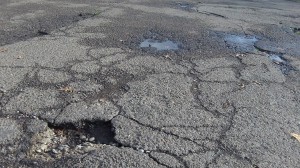
Does this need to be maintained or repaired?
While we’re on the subject of Albany’s many crumbling streets, especially in the oldest parts of town, let’s take a quick look at the street fees that city residents pay. “What street fees?” you are wondering. Since the 1990s, Albany has levied a 5 percent “in lieu of franchise fee” on water and sewer bills, but not directly so it does not show up on the monthly statements the way similar government fees are itemized on other utility bills.
“Effective July 1, 1999,” the municipal code says in section 10.01.070, “as compensation for the use of city-owned rights-of-way, the sewer fund shall pay to the street fund an in-lieu-of franchise fee in the amount of five percent of the sewer user receipts.” There’s a similarly worded section in the code relating to water service, also dedicating 5 percent of revenue to the street fund. The money from both amounted to about $848,000 in fiscal 2011. It grows a little every year, and this budget year the street fund expects to receive just under $1 million from that source.
Ordinary franchise fees on telephone, gas, electricity and cable TV go straight to the city’s general fund, a point the city manager made when he suggested the other day that some of the sewer and water fees go there as well next year. The difference is that the sewer and water franchise payments are dedicated to the street fund by council ordinance.
An argument can be made that every household in town with water and sewer service pays its share of this money, so the benefits ought to be spread around. This implies there ought to be at least a plan to fix all the streets over time, not just those with the most traffic.
Councilman Floyd Collins, a former public works director, used Facebook to add this to the discussion: “Many of the downtown streets have simply had asphalt placed over the top of the original streets. Some still have bricks under the pavement. The old streets were not designed to support the volumes of traffic or the loads the traffic carries. To make things even more difficult, generally the water, sewer and storm drainage need to be replaced in advance of rebuilding the local streets… Streets require routine maintenance to extend their life. Failure to maintain results (in) long term higher cost to rebuild them upon failure. Just like our homes, avoid maintenance and wait for failure generally cost a lot more.”
I would guess that it’s too late for maintenance on some of the oldest streets. With that in mind, perhaps the water and sewer franchise fees could be saved and used for starting a program of getting them repaired. (hh)


Albany’s indirect street fees
Does this need to be maintained or repaired?
While we’re on the subject of Albany’s many crumbling streets, especially in the oldest parts of town, let’s take a quick look at the street fees that city residents pay. “What street fees?” you are wondering. Since the 1990s, Albany has levied a 5 percent “in lieu of franchise fee” on water and sewer bills, but not directly so it does not show up on the monthly statements the way similar government fees are itemized on other utility bills.
“Effective July 1, 1999,” the municipal code says in section 10.01.070, “as compensation for the use of city-owned rights-of-way, the sewer fund shall pay to the street fund an in-lieu-of franchise fee in the amount of five percent of the sewer user receipts.” There’s a similarly worded section in the code relating to water service, also dedicating 5 percent of revenue to the street fund. The money from both amounted to about $848,000 in fiscal 2011. It grows a little every year, and this budget year the street fund expects to receive just under $1 million from that source.
Ordinary franchise fees on telephone, gas, electricity and cable TV go straight to the city’s general fund, a point the city manager made when he suggested the other day that some of the sewer and water fees go there as well next year. The difference is that the sewer and water franchise payments are dedicated to the street fund by council ordinance.
An argument can be made that every household in town with water and sewer service pays its share of this money, so the benefits ought to be spread around. This implies there ought to be at least a plan to fix all the streets over time, not just those with the most traffic.
Councilman Floyd Collins, a former public works director, used Facebook to add this to the discussion: “Many of the downtown streets have simply had asphalt placed over the top of the original streets. Some still have bricks under the pavement. The old streets were not designed to support the volumes of traffic or the loads the traffic carries. To make things even more difficult, generally the water, sewer and storm drainage need to be replaced in advance of rebuilding the local streets… Streets require routine maintenance to extend their life. Failure to maintain results (in) long term higher cost to rebuild them upon failure. Just like our homes, avoid maintenance and wait for failure generally cost a lot more.”
I would guess that it’s too late for maintenance on some of the oldest streets. With that in mind, perhaps the water and sewer franchise fees could be saved and used for starting a program of getting them repaired. (hh)
Tags: Albany City Council, Albany street fees, Albany street repairs